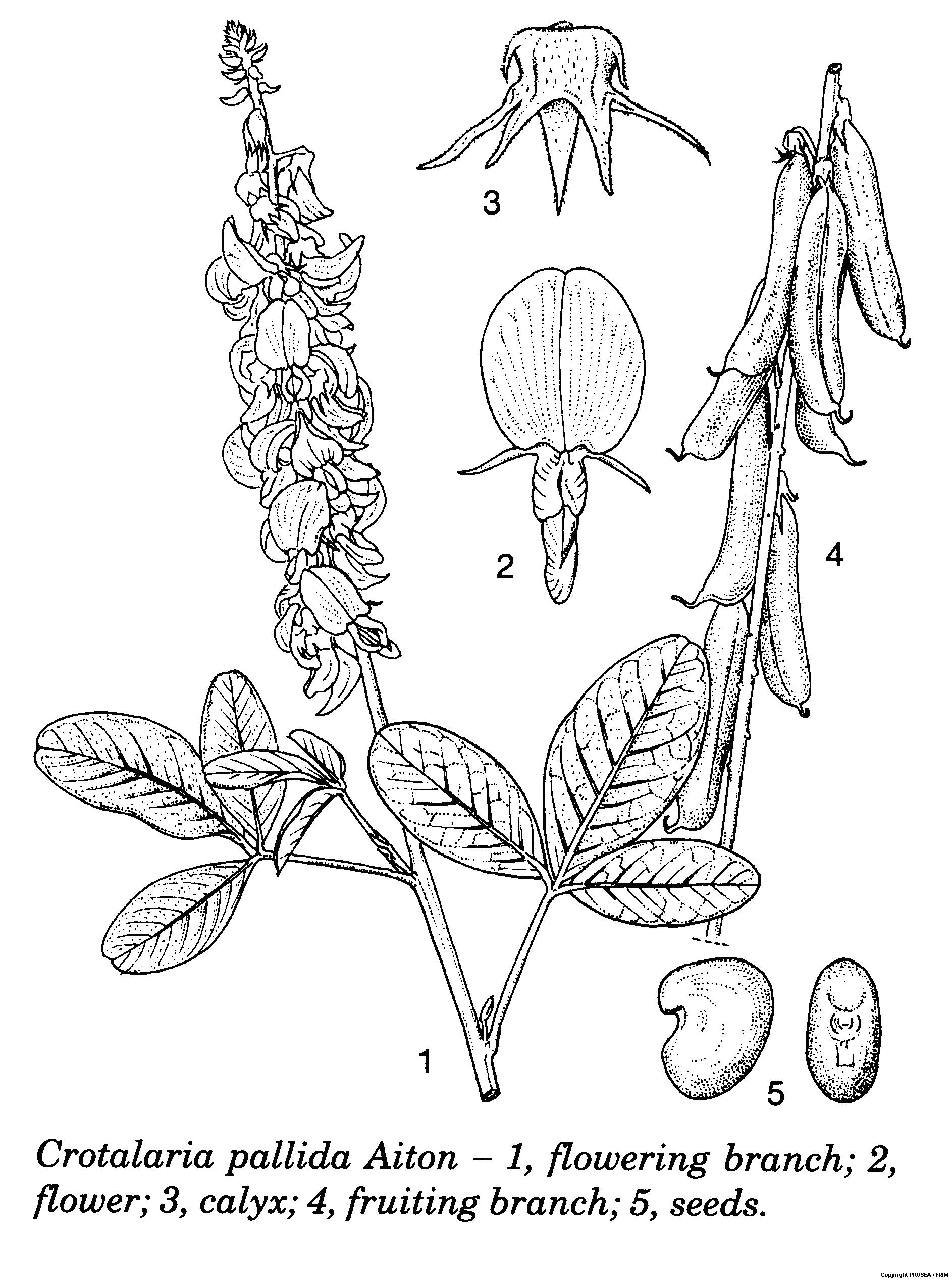Crotalaria pallida Aiton
Family
Leguminosae
Synonyms
Crotalaria mucronata Desv., Crotalaria striata DC., Crotalaria siamica Williams.
Vernacular Names
|
Malaysia |
Giring-giring, rang-rang. |
|
English |
Smooth rattlebox, salts rattlebox. |
|
Indonesia |
Kekecrekan (Sundanese), orok-orok (Javanese), telpok (Madurese). |
|
Philippines |
Gorunggorung, kolong-kolong, tambarisa. |
|
Cambodia |
Châangrô:ng sva:, dâang höt khmaôch, sandaèk kû.:öy. |
|
Laos |
Hingx ha:y. |
|
Thailand |
Hinghai, honghai. |
|
Vietnam |
l[uj]c l[aj]c ba l[as] tr[of]n, c[aa]y mu[oox]ng tr[af], c[af] ph[ee] r[uw]ng. |
Geographical Distributions
Crotalaria pallida is probably a native of tropical Africa, but its natural distribution is obscured by widespread cultivation and subsequent pantropical naturalisation. In Asia, it is common in India and Sri Lanka and throughout Southeast Asia.
Description
Crotalaria pallida is an erect, well-branched annual or short-lived perennial herb, and measures up to 1.5(-3) m tall. Its stem is stout, covered with fine hairs and with slender longitudinal grooves. The branches are densely appressed hairy.
The leaves are trifoliolate, with slender stipules which measure up to 3 mm long, caducous or absent. The petiole is 2-8.5 cm long. The leaflets are variable, elliptical to obovate, measuring 3-13 cm x 2-5(-7) cm, obtuse, often notched at the extremity, sometimes apiculate, hairless above and thinly appressed hairy beneath.
The inflorescence is a terminal, short raceme stalk, measures 15-40 cm long and 20-30-flowered. The bracts are linear, measure up to 5 mm long and caducous. The bracteoles are 1-3 mm long, inserted at the base of the sepal and slender. The pedicel is 4 mm long. The sepal is deflexed, tubular, measures 6-8 mm long, appressed hairy and with 5 unequal lobes. The petal is about 1.5 cm long, yellow and often reddish-brown veined. The elliptical is standard, and measuring 11 mm x 8 mm. The wings measure 8 mm x 3 mm and oblong-Ianceolate. The keel is shallowly rounded, measuring 11 mm x 4 mm, and with narrow and slightly projecting beak.
The pod is shortly stipitate, subcylindrical, measuring 3-5 cm x 6-8 mm, contains 30-40 seeds, nearly smooth and yellowish when mature. The seed is heart-shaped, measuring 3 mm x 2 mm, shiny, with mottled ochre and dark grey-green or brown.
Ecology / Cultivation
Crotalaria pallida occurs naturally on river banks, edges of lakes, extending into woodlands, grasslands and waste places from 0-1000 m altitude and may be planted to 1800 m. It is light-demanding and shade strongly retards development. It grows in a wide range of annual rainfall conditions, from 850 mm to over 3000 mm and occurs occasionally in rather dry locations. The average annual temperature varies from 16-26°C. Tests in Florida showed satisfactory growth in a wide range of soils, except on peat soils developed under coarse grass. In West Africa, it is considered wellsuited to sandy soils.
In Thailand, it is found in the tidal zone, growing in association with Avicennia sphaerocarpa Stapf ex Ridley and Ipomoea pes-caprae (L.) R. Br. It also occurs in open, secondary thickets with Bambusa bambos (L.) Voss, Chromolaena odorata (L.) R.M. King & Robinson and Lantana camara L.
Line Drawing / Photograph
References
- Plant Resources of South-East Asia No.11: Auxiliary plants.



